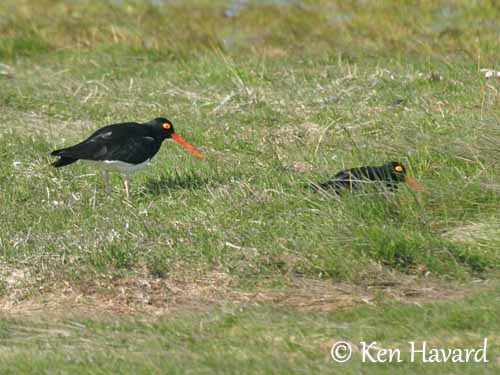
Fr: Huîtrier de Garnot
All: Magellanausternfischer
Esp: Ostrero Magallánico
Ita: Beccaccia di mare di Magellano
Nd: Magelhaenscholekster
Sd: Magellanstrandskata
Photographers:
John Anderson
John Anderson Photo Galleries
Ken Havard
My Bird Gallery & Flickr gallery 1 & Flickr gallery 2
Eduardo Andrés Jordan
MIS AVES – AVES DE ARGENTINA
Text by Nicole Bouglouan
Sources :
HANDBOOK OF THE BIRDS OF THE WORLD Vol 3 by Josep del Hoyo-Andrew Elliott-Jordi Sargatal - Lynx Edicions - ISBN : 8487334202
SHOREBIRDS by Peter Hayman, John Marchant and Tony Prater – Christopher Helm – 1986 – ISBN: 0747014035
BirdLife International (BirdLife International)
Arthur Grosset's Birds (Arthur Grosset)
Neotropical Birds – Cornell Lab of Ornithology
Magellanic Oystercatcher
Haematopus leucopodus
Charadriiformes Order – Haematopodidae Family
INTRODUCTION:
The Magellanic Oystercatcher is behaviourally unique among oystercatchers in several respects, and these differences suggest that it is a primitive species. In addition, this species shows several close affinities with the oldest known oystercatcher fossil.
DESCRIPTION OF THE BIRD:
Biometrics:
Length: 42-46 cm
The adult has black dorsal coloration rather than brownish like other oystercatchers. Another unique feature, it has unmarked white secondaries, and the white-tipped greater coverts form a conspicuous white triangular patch on the inner half of the wing. Primaries are black, well visible in flight. The tail is white with broad black terminal band.
Head, neck, chin, throat and upper breast are black.
On the underparts, the body is white. On the underwing, primary coverts and lesser coverts are black. Primary flight feathers are black too, like the leading edge. Rest of underwing is white.
The long, rather slim bill is red-orange. The eyes are yellow, surrounded by bare, bright yellow eyering. Legs and feet are pale pink.
Both sexes are similar.

The juvenile has browner upperparts with narrowly buff-edged feathers. The bare parts are duller. The bill is brownish with reddish base. The eyering is dull brownish. Legs and feet are greyish.
RANGE:
The Magellanic Oystercatcher occurs in SC Chile and SC Argentina, S to Cape Horn. It is also present on Falkland Islands.
HABITAT:
The Magellanic Oystercatcher breeds inland in short-grassy areas close to freshwater pools. It may breed too in upland grasslands, at least up to 1000 metres of elevation in the Andean foothills in Argentina. In Falkland Islands, it breeds on coastal sandy beaches.
Outside the breeding season, it forms large flocks on rocky shores and coasts.

The adults can be very aggressive against intruders, including humans and birds of prey. The long bill is used as a weapon towards the predators.
The Magellanic Oystercatcher only performs seasonal movements after breeding. However, the southernmost population often moves from Tierra del Fuego to N in winter.
The flight is strong and low. This bird can swim well if necessary.
REPRODUCTION OF THIS SPECIES:
In Tierra del Fuego, the laying occurs in October/November, with a peak between late September and late October. In the Falklands, the breeding period occurs from mid-September to mid-December, with the laying around October.
The nest is on the ground. This is usually a scrape on sand, but also on dead kelp, sometimes protected by a nearby plant. It is often placed on a slightly grassy hillock. In the Falklands, the nest is a hollow in open ground above the high water line.
The female lays 1-2 olive-brown eggs with blackish-brown spots. The eggs have cryptic colour, making them almost invisible on the ground. The incubation period is unknown, but for most species, it ranges between 27 and 30 days, and we can suggest that the same time is required here. At hatching, the chicks have pale buff down with dark markings and blackish crown.
The female performs most of the nesting duties while the male defends the territory and the nest, but it may take part to incubation.
The fledging period ranges between 33 and 49 days, according to the species. The young are still fed by both parents after fledging, and they may remain in family group for several months.
PROTECTION / THREATS / STATUS:
The Magellanic Oystercatcher is generally common to abundant, and mainly in the southern parts of the range. It has restricted distribution but with limited human impact on the habitat.
The Falkland’s population is estimated at about 10,000 breeding pairs.
The global population is suspected to be stable and currently, the Magellanic Oystercatcher is evaluated as Least Concern.
CALLS AND SONGS: SOUNDS BY XENO-CANTO
The Magellanic Oystercatcher’s contact and alarm calls usually include the typical “peep” but the most frequent sound is a disyllabic whistle “hoo-eep” or a soft and plaintive “pee-you”.
During the displays, it utters a typical, repeated piping “pee-pee”.
BEHAVIOUR IN THE WILD:
The Magellanic Oystercatcher feeds primarily on mussels, but it also takes limpets, crabs and marine worms. Inland, it feeds mostly on insect larvae and earthworms.
It uses its long, thin bill for feeding. Several techniques are used depending on the type of prey. The limpets which are attached to the rock are knocked or levered off with the bill. The bivalves are hammered open to reach the flesh.
Outside the breeding season, large flocks sometimes gather on sandy beaches around stony mussel-beds. Flocks of up to 150 individuals are observed in Falkland Islands.
During the breeding season, the Magellanic Oystercatcher displays. All oystercatchers perform a typical head-down display while giving piping calls. This species also performs a spectacular display with the tail held vertically, the wings drooped and head and bill lowered. This display enhances the contrasting black-and-white plumage pattern and the conspicuous bright yellow eyering. These displays are accompanied by varied piping calls.
